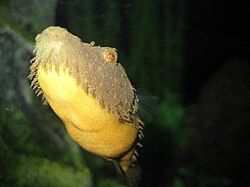| Pao baileyi | |
|---|---|
 | |
| Scientific classification | |
| Kingdom: | Animalia |
| Phylum: | Chordata |
| Class: | Actinopterygii |
| Order: | Tetraodontiformes |
| Family: | Tetraodontidae |
| Genus: | Pao |
| Species: | P. baileyi |
| Binomial name | |
| Pao baileyi (Sontirat, 1989) | |
| Synonyms | |
| |
Pao baileyi, [2] the hairy pufferfish, is a species of pufferfish usually found in the rocky habitats, including rapids, of the Mekong mainstream and its larger tropical freshwater tributaries. [3]
